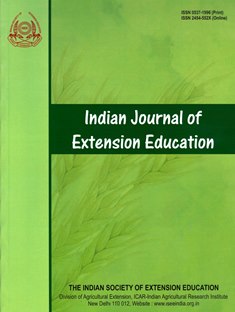A Scale to Measure Farmers’ Perception of Capacity Needs under NICRA
DOI:
https://doi.org/10.48165/IJEE.2025.614RT04Keywords:
Climate resilience, Capacity building, Perception scale, Extension services, Farmer training, NICRA initiatives, Adaptive strategiesAbstract
A study conducted in 2024 developed and standardized a summated-rating scale to measure farmers’ perceptions of capacity needs under the National Innovations in Climate Resilient Agriculture (NICRA) program. An initial pool of 155 statements was generated from literature and expert consultation, then screened by 100 judges (41 responses) and reduced to 80 items using a relevancy index threshold of >80. The 80 items were pilot tested with 32 farmers in a non-sampled area; item analysis followed Edwards’ top/ bottom 25 per cent t-test procedure, and 31 items with t > 2.145 were retained. The final instrument’s reliability was assessed using the split-half method with 40 respondents (odd–even split), yielding a coefficient of 0.955. Criterion validity was examined by correlating perception scores with operational landholding; the correlation was moderate (r = 0.531), supporting the scale’s validity. The resulting scale provides a consistent and interpretable measure of farmers’ capacity-need perceptions under NICRA and can inform targeting of training, advisory, and monitoring interventions. The tool is adaptable to other locations and projects with minor contextual changes.
Downloads
References
Ashoka, N., Harshavardhan, M., Hongal, S., Meti, S., Raju, R., Patil, G. I., & Shashidhara, N. (2022). Farmers’ acuity on climate change in the Central Dry Zone of Karnataka. Indian Journal of Extension Education, 58(3), 136–141.
Gupta, A. (2021). Climate action in India – Challenges and ways forward in agriculture. Journal of Environmental Toxicology Studies, 5(S1), 001.
Gupta, S. K., Nain, M. S., Singh, R., & Mishra, J. R. (2022). Development of scale to measure agripreneurs attitude towards entrepreneurial climate, Indian Journal of Extension Education, 58(2), 153-157. http://doi.org/10.48165/IJEE.2022.58237
Harpe, S. E. (2015). How to analyze Likert and other rating scale data. Currents in Pharmacy Teaching and Learning, 7(6), 836– 850. https://doi.org/10.1016/j.cptl.2015.08.001
Hayat, M. K., Khan, A. R., Klutse, S., Rasool, M. W., & Mohsin, M. (2025). Empowering crops: How organic, agronomic practices and technology can fortify our fields. World News of Natural Sciences, 59, 358–383.
Jaisridhar, P., Sankhala, G., & Sangeetha, S. (2013). A scale to measure the attitude of dairy farmers towards Kisan Call Centre-based extension services. Madras Agricultural Journal, 100(3), 224– 227.
Khan, M. N., Wahab, S., Wahid, N., Shah, S. N., Ullah, B., Kaplan, A., Razzaq, A., Bibi, M., Suleman, F., & Ali, B. (2025). Impact of climate change on yield and quality of legumes. In Challenges and solutions of climate impact on agriculture (pp. 85–111). Academic Press.
Kotir, J. H. (2011). Climate change and variability in Sub-Saharan Africa: A review of current and future trends and impacts on agriculture and food security. Environment, Development and Sustainability, 13, 587–605.
Kour, R., Slathia, P. S., Peshin, R., Singh, A. P., Sharma, M., & Kumar, R. (2025). Scale to measure the attitude of farmers towards the maize and wheat crops. Indian Journal of Extension Education, 61(3), 109–112.
Manju, P. S., Jayalekshmi, G., Mohanraj, M., Mohamed Aseemudheen, M., & Manobharathi, K. (2024). National innovations in climate resilient agriculture (NICRA): The reservoir of resilience enhancement. International Journal of Agriculture Extension and Social Development, 7(2), 340–346. https://doi.org/10.33545/ 26180723.2024.v7.i2e.344
Nguyen, T. P. L., Seddaiu, G., Virdis, S. G. P., Tidore, C., Pasqui, M., & Roggero, P. P. (2016). Perceiving to learn or learning to perceive? Understanding farmers’ perceptions and adaptation to climate uncertainties. Agricultural Systems, 143, 55–66. https://doi.org/ 10.1016/j.agsy.2016.01.001
Prasad, Y. G., Maheswari, M., Dixit, S., Srinivasarao, C., Sikka, A. K., Venkateswarlu, B., Sudhakar, N., Prabhu Kumar, S., Singh, A. K., Gogoi, A. K., & Singh, A. K. (2014). Smart practices and technologies for climate resilient agriculture. Central Research Institute for Dryland Agriculture (ICAR), Hyderabad.
Rezigalla, A. A. (2022). Item analysis: Concept and application. Medical education for the 21st century, 1-16.
Saini, S., Pimpale, A., & Shirsath, P. B. (2020). Increasing adaptive capacity of farmers to climate change. https://cgspace.cgiar.org/ items/d940cb80-f78f-48b5-95d2-b58d85ac8336
Salam, P., Rahman, S., Verma, H., & Saran, V. (2025). Development of a standardised scale to measure farmers’ attitude towards indigenous cattle conservation: A methodological approach. Indian Journal of Extension Education, 61(3), 92–96.
Shitu, G. A., Nain, M. S., & Kobba, F. (2018). Development of Scale for assessing farmers’ attitude towards precision conservation agricultural practices. Indian Journal of Agricultural Sciences, 88(3), 499-504.
Thakur, D., Chander, M., & Sinha, S. K. (2017). A scale to measure attitude of farmers towards social media use in agricultural extension. Indian Research Journal of Extension Education, 17(3), 10-15.
Downloads
Published
Issue
Section
License

This work is licensed under a Creative Commons Attribution-NonCommercial-NoDerivatives 4.0 International License.

